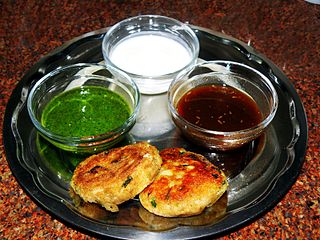 W
WA chutney is a condiment or sauce in the cuisines of the Indian subcontinent. Chutneys are made in a wide variety of forms, such as a tomato relish, a ground peanut garnish, yogurt or curd, cucumber, spicy coconut, spicy onion or mint dipping sauce.
 W
WThis is a list of notable chutney varieties. Chutney is a sauce and condiment in Indian cuisine, the cuisines of the Indian subcontinent and South Asian cuisine. It is made from a highly variable mixture of spices, vegetables, or fruit. Chutney originated in India, and is similar in preparation and usage to a pickle. In contemporary times, chutneys and pickles are a mass-produced food product.
 W
WChammanthi podi is a dry condiment and chutney from the South Indian state of Kerala. Usually, regular coconut chutneys would spoil the same day without refrigeration, so making chammanthi podi was a way to preserve the chutney for months.
 W
WCoconut chutney is a Southern Indian chutney-side-dish and condiment, a common in the Indian subcontinent. The condiment is made with coconut pulp ground with other ingredients such as green chillies, tamarind, salt, coriander and water. Coconut chutney is made with both red chillies or green chillies. It is served with dosas, idli, bajji, bonda, and vada. In Karnataka coconut chutney is also served with famous rice dishes such as pulao, puliyogare, tomato bath, vangi bath etc.
 W
WDahi chutney is strained dahi that is mixed into a chutney of mint and onions, originating from the Indian subcontinent. It is popular in South India and is a side dish along with Mirchi ka salan for the popular Hyderabadi biryani.
 W
WEromba is an ethnic dish of the Meitei community of Manipur, India.
 W
WGarlic chutney, also referred to as lahsun chutney, lahsun ki chutney, lehsun chutney and bellulli chutney, is a chutney, originating from the Indian subcontinent, made from fresh garlic, dry or fresh coconut, groundnuts and green or red chili peppers. Cumin and tamarind are also sometimes used as ingredients. It is prepared in both wet and dried forms. The wet variety is made with fresh grated coconut and is typically served immediately after preparation.
 W
WGreen mango chutney, also known as raw mango chutney, is an Indian chutney prepared from unripe mangoes. Ripe mangoes are sweet and are not used for chutneys as they are eaten raw. Green unripe mangoes are hard and sour, and they are cooked as chutneys. Mango chutneys are tangy in taste.
 W
WKasundi is the Asian or Bengali variety of mustard sauce or relish. It has the pungent paste of fermented mustard seeds, spices and sometimes dried mangoes, dried Indian plum and olives. Kasundi is popular as a dipping sauce in Bengali cuisine.
 W
WLjutenica, lyutenitsa or lutenica is a vegetable relish or chutney in Bulgarian, Macedonian and Serbian cuisines.
 W
WPeanut chutney is a mildly spicy chutney side dish, originating from the Indian subcontinent, that can be used with several snack foods and breakfast foods.
 W
WSaunth, is a sweet chutney used in Indian chaats. It is made from dried ginger (sooth) and tamarind paste, hence the name. The chutney is brownish-red in colour.
 W
WTomato chutney is a type of chutney, native to the Indian subcontinent, prepared using tomatoes as the primary ingredient. The tomatoes can be diced, mashed or pulped, and additional typical ingredients used include ginger, chilli, sugar, salt, aam papad, raisin, dates and spices and additionally onion, garlic and peanut or dal for the south Indian version. It can be prepared using ripe red tomatoes or green tomatoes. It can be eaten fresh after preparation, stored in a refrigerator, and can be bottled or canned and stored for later use. Homemade tomato chutney that is canned can have an improved flavor, due to the ingredients intermingling while the product is stored.